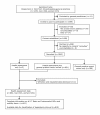Capability and dependency in the Newcastle 85+ cohort study. Projections of future care needs
- PMID: 21542901
- PMCID: PMC3097155
- DOI: 10.1186/1471-2318-11-21
Capability and dependency in the Newcastle 85+ cohort study. Projections of future care needs
Abstract
Background: Little is known of the capabilities of the oldest old, the fastest growing age group in the population. We aimed to estimate capability and dependency in a cohort of 85 year olds and to project future demand for care.
Methods: Structured interviews at age 85 with 841 people born in 1921 and living in Newcastle and North Tyneside, UK who were permanently registered with participating general practices. Measures of capability included were self-reported activities of daily living (ADL), timed up and go test (TUG), standardised mini-mental state examination (SMMSE), and assessment of urinary continence in order to classify interval-need dependency. To project future demand for care the proportion needing 24-hour care was applied to the 2008 England and Wales population projections of those aged 80 years and over by gender.
Results: Of participants, 62% (522/841) were women, 77% (651/841) lived in standard housing, 13% (106/841) in sheltered housing and 10% (84/841) in a care home. Overall, 20% (165/841) reported no difficulty with any of the ADLs. Men were more capable in performing ADLs and more independent than women. TUG validated self-reported ADLs. When classified by 'interval of need' 41% (332/810) were independent, 39% (317/810) required help less often than daily, 12% (94/810) required help at regular times of the day and 8% (67/810) required 24-hour care. Of care-home residents, 94% (77/82) required daily help or 24-hour care. Future need for 24-hour care for people aged 80 years or over in England and Wales is projected to increase by 82% from 2010 to 2030 with a demand for 630,000 care-home places by 2030.
Conclusions: This analysis highlights the diversity of capability and levels of dependency in this cohort. A remarkably high proportion remain independent, particularly men. However a significant proportion of this population require 24-hour care at home or in care homes. Projections for the next 20 years suggest substantial increases in the number requiring 24-hour care due to population ageing and a proportionate increase in demand for care-home places unless innovative health and social care interventions are found.
Figures
Similar articles
-
Is late-life dependency increasing or not? A comparison of the Cognitive Function and Ageing Studies (CFAS).Lancet. 2017 Oct 7;390(10103):1676-1684. doi: 10.1016/S0140-6736(17)31575-1. Epub 2017 Aug 15. Lancet. 2017. PMID: 28821408 Free PMC article.
-
Forecasting the care needs of the older population in England over the next 20 years: estimates from the Population Ageing and Care Simulation (PACSim) modelling study.Lancet Public Health. 2018 Sep;3(9):e447-e455. doi: 10.1016/S2468-2667(18)30118-X. Epub 2018 Aug 31. Lancet Public Health. 2018. PMID: 30174210 Free PMC article.
-
Nowcasting and forecasting the care needs of the older population in China: analysis of data from the China Health and Retirement Longitudinal Study (CHARLS).Lancet Public Health. 2022 Dec;7(12):e1005-e1013. doi: 10.1016/S2468-2667(22)00203-1. Epub 2022 Nov 21. Lancet Public Health. 2022. PMID: 36423656 Free PMC article.
-
Components, impacts and costs of dementia home support: a research programme including the DESCANT RCT.Southampton (UK): NIHR Journals Library; 2021 Jun. Southampton (UK): NIHR Journals Library; 2021 Jun. PMID: 34181370 Free Books & Documents. Review.
-
[Can the costs of future needs of health and social services for the elderly be calculated?].Lakartidningen. 2001 Sep 19;98(38):4042-8. Lakartidningen. 2001. PMID: 11602962 Review. Swedish.
Cited by
-
Is late-life dependency increasing or not? A comparison of the Cognitive Function and Ageing Studies (CFAS).Lancet. 2017 Oct 7;390(10103):1676-1684. doi: 10.1016/S0140-6736(17)31575-1. Epub 2017 Aug 15. Lancet. 2017. PMID: 28821408 Free PMC article.
-
Describing transitions in residential status over 10 years in the very old: results from the Newcastle 85+ Study.Age Ageing. 2022 Mar 1;51(3):afac056. doi: 10.1093/ageing/afac056. Age Ageing. 2022. PMID: 35348585 Free PMC article.
-
Observational Evidence of For-Profit Delivery and Inferior Nursing Home Care: When Is There Enough Evidence for Policy Change?PLoS Med. 2016 Apr 19;13(4):e1001995. doi: 10.1371/journal.pmed.1001995. eCollection 2016 Apr. PLoS Med. 2016. PMID: 27093442 Free PMC article.
-
The contribution of diseases to the male-female disability-survival paradox in the very old: results from the Newcastle 85+ study.PLoS One. 2014 Feb 7;9(2):e88016. doi: 10.1371/journal.pone.0088016. eCollection 2014. PLoS One. 2014. PMID: 24516578 Free PMC article.
-
The personal and health service impact of falls in 85 year olds: cross-sectional findings from the Newcastle 85+ cohort study.PLoS One. 2012;7(3):e33078. doi: 10.1371/journal.pone.0033078. Epub 2012 Mar 9. PLoS One. 2012. PMID: 22427954 Free PMC article.
References
-
- Tomassini C. The demographic characteristics of the oldest old in the United Kingdom. Pop Trends. 2005. pp. 15–22. - PubMed
-
- Femia EE, Zarit SH, Johansson B. The disablement process in very late life: a study of the oldest-old in Sweden. Journal of Gerontology: Psychological Sciences. 2001;56B(1):P12–P23. - PubMed
Publication types
MeSH terms
Grants and funding
LinkOut - more resources
Full Text Sources
Medical



